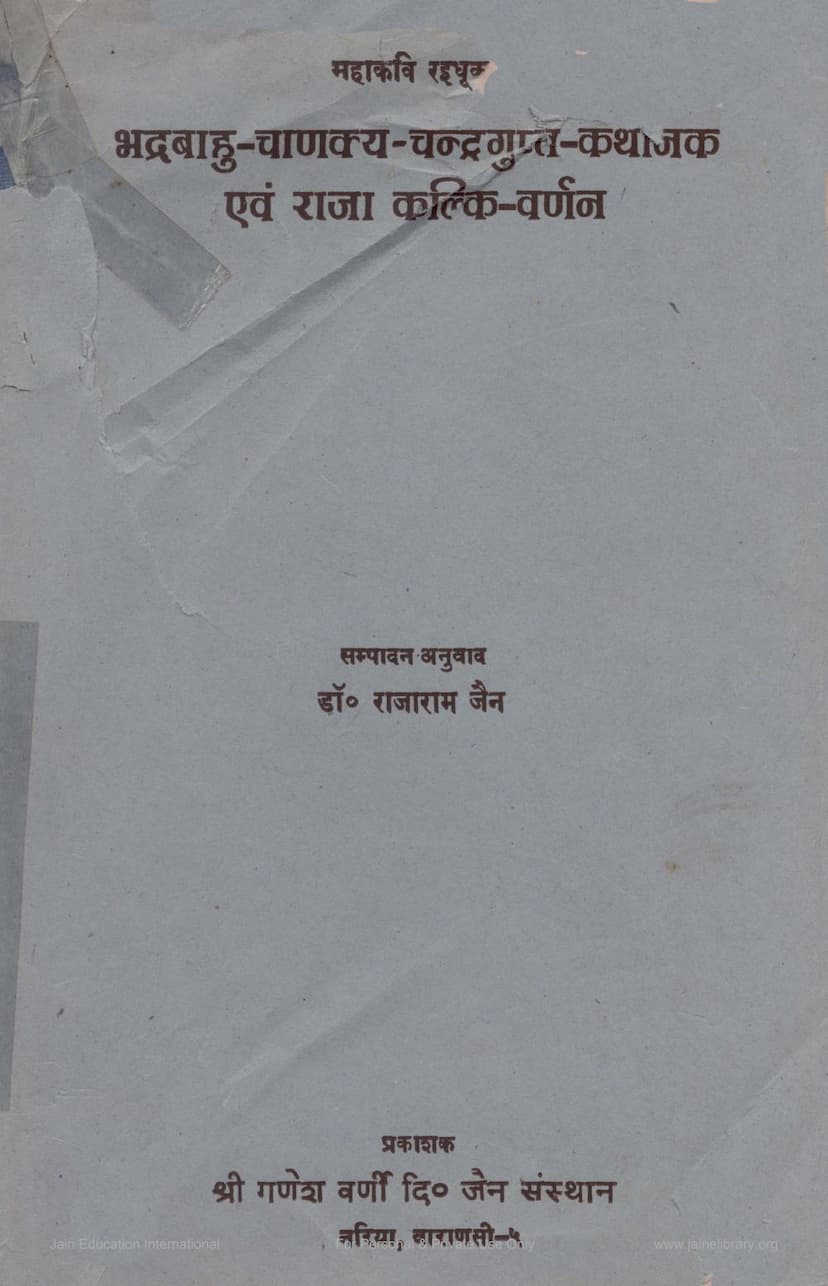Bhadrabahu Chanakya Chandragupt Kathanak Evam Raja Kalki Varnan
Added to library: September 1, 2025

Summary
This Jain text, titled "Bhadrabahu Chanakya Chandragupt Kathanak evam Raja Kalki Varnan" (The Narrative of Bhadrabahu, Chanakya, Chandragupta, and the Description of King Kalki), authored by Rajaram Jain and published by Shri Ganeshprasad Varni Digambar Jain Sansthan, is a significant scholarly work that critically edits and translates a hitherto unpublished Apabhramsha manuscript. The work focuses on the story of three pivotal figures in ancient Indian history – Acharya Bhadrabahu, Chanakya, and Chandragupta Maurya – as presented by the Mahakavi Raidhū, a prominent poet in Apabhramsha literature.
Here's a comprehensive summary of the text, drawing from its various sections:
1. Significance of Jain Sources in Historical Research: The introductory remarks highlight the historical indifference shown by mainstream historians towards Jain sources, despite their immense value for reconstructing ancient Indian history and culture. The book aims to rectify this by presenting a scientific and analytical study of these previously neglected sources. Dr. Raja Ram Jain is lauded for his commendable work in exploring this "virgin field" for the benefit of researchers.
2. The Manuscript and Mahakavi Raidhū: The present work is significant as it is the first publication and critical editing of this particular narrative in the Apabhramsha language, which was unknown and unpublished until Dr. Jain's efforts. Mahakavi Raidhū, a renowned poet of the 15th-16th century, is recognized for his prolific literary output and his ability to illuminate various aspects of Indian history, culture, and artistic activities through his poetry. The book builds upon Dr. Jain's previous work on Raidhū's literature.
3. Key Narratives and Historical Figures: The manuscript by Raidhū covers:
- Acharya Bhadrabahu: The narrative details Bhadrabahu's life from his birth in a Brahmin family in Kautukapura, his early signs of greatness, his tutelage under Acharya Govardhana, and his eventual attainment of the status of Shrutakevalin (a highly enlightened Jain scholar). It highlights the tradition of Shrutakevalins and the lineage of Jain spiritual leaders.
- Chanakya: The text presents a Jain perspective on Chanakya, his parentage (son of Chanaka), his alternative names (Kautilya, Vishnugupta), and his pivotal role in politics. The narrative describes his deep resentment towards King Nanda, his alliance with Chandragupta, and his strategic brilliance in overthrowing Nanda and establishing Chandragupta on the throne of Pataliputra. The Jain tradition of Chanakya's conversion or strong affiliation with Jainism is also touched upon.
- Chandragupta Maurya: The story follows Chandragupta from his early life, his association with Chanakya, his rise to power, and his eventual reign. A notable aspect highlighted is the description of sixteen dreams seen by Chandragupta (or his descendant Nakula's son, Chandragupta) and their interpretation by Acharya Bhadrabahu. This interpretation leads to Chandragupta's renunciation and adoption of Jain asceticism, eventually accompanying Bhadrabahu to South India.
- King Nanda: The text provides details about King Nanda of Pataliputra, his minister Sakata, the circumstances leading to Sakata's imprisonment and eventual reinstatement due to his acumen in dealing with a frontier enemy (possibly Puru or Parvataka).
- King Kalki: A unique and significant contribution of this manuscript is the description of the "Kalki" kings, particularly the first wicked Kalki king, Chaturmukha of Pataliputra, and the last Kalki king, Jalamanthana. This section offers a narrative of the decline of righteousness and the rise of corruption during the Kalki period, even touching upon the last phase of the Fifth Era and the beginning of the Sixth Era in Jain cosmology.
4. Distinctive Features of Raidhū's Work: Raidhū's narrative is distinguished by several unique elements not found in other Bhadrabahu-Chanakya-Chandragupta accounts:
- Description of Administrative Systems of Kalki Kings: This is a new dimension added to the traditional narratives.
- Mention of Śruta-Pañcami Parva Start: The text includes details about the commencement of the Śruta-Pañcami festival.
- Shatkal Varnan (Description of Six Eras): The manuscript elaborates on the six cosmic time periods in Jain cosmology, which is a significant addition.
- Variant Genealogies and Names: The text mentions Ashoka's son as "Nakula" instead of the more common "Kunala," and Pataliputra as "Pachalipura," which holds historical significance.
- Detailed Description of Chandragupta's Sixteen Dreams: This detailed account is not found in other classical texts like Harisena's Kathakosa and is largely based on the Punyasravakathakosa of Ramachandra Mumukshu.
5. Comparative Study of Bhadrabahu Narratives: The book undertakes a detailed comparative study of various existing Bhadrabahu narratives from different authors like Harisena, Ramachandra Mumukshu, Shrichandra, and Ratnanandi. This analysis helps in understanding the evolution and variations in these stories and identifying the unique contributions of each tradition.
6. Social and Religious Aspects: The text sheds light on:
- The lineage of kings: It traces the lineage from Chandragupta through Bindusara, Ashoka, Nakula, and Chandragupta II (Samprati), providing a Jain perspective on these rulers.
- The emergence of different monastic orders: The narrative touches upon the schisms within the Jain monastic community, leading to the formation of the Shvetambara and YapanIya Samghas, tracing their origins to the influence of certain royal women and their gurus.
- The influence of Jainism: It highlights the interaction of Jainism with other contemporary religious and political systems.
- The description of Kalikala: The text provides details about the characteristics of the Fifth Era (Kalki period) and the transition to the Sixth Era, depicting a decline in moral values and societal order.
7. Scholarly Contribution: Dr. Raja Ram Jain's editing and translation are praised for making this valuable Apabhramsha text accessible to a wider audience, enriching Indological studies and shedding light on previously unknown aspects of ancient Indian history and Jain tradition. The work is presented with an exhaustive introduction, critical notes, appendices, and an index, making it a valuable resource for researchers.
In essence, this book is a scholarly endeavor to unearth and present a unique Jain narrative about significant historical figures and cosmological periods, thereby contributing significantly to the understanding of ancient Indian history and Jain literature.